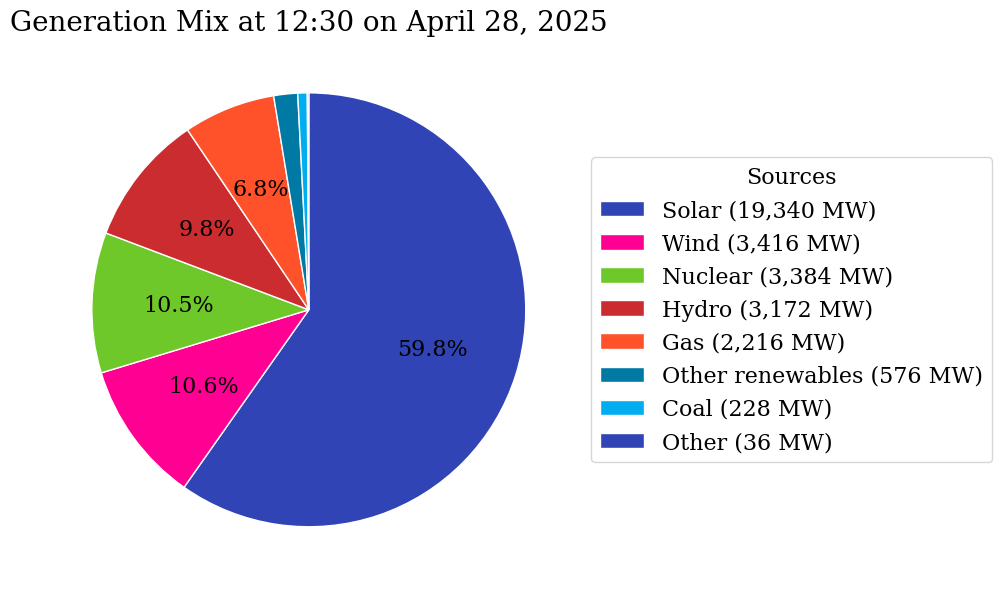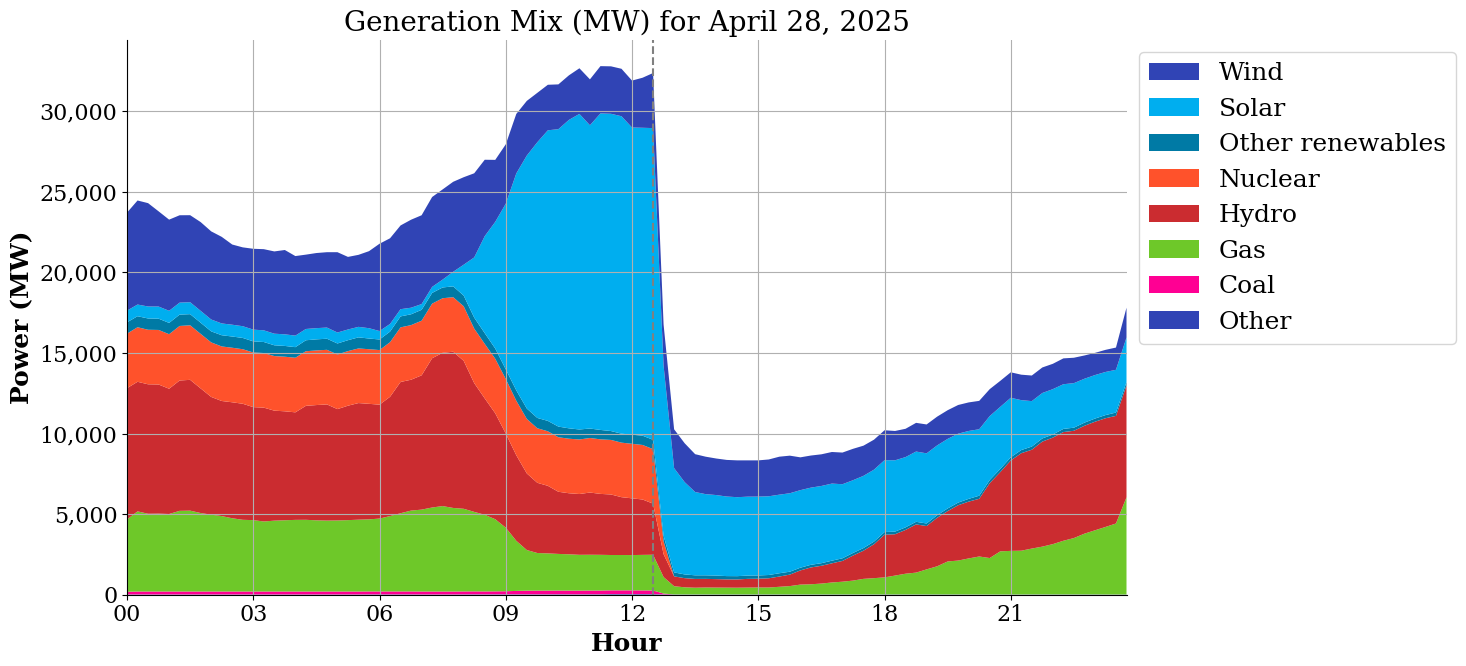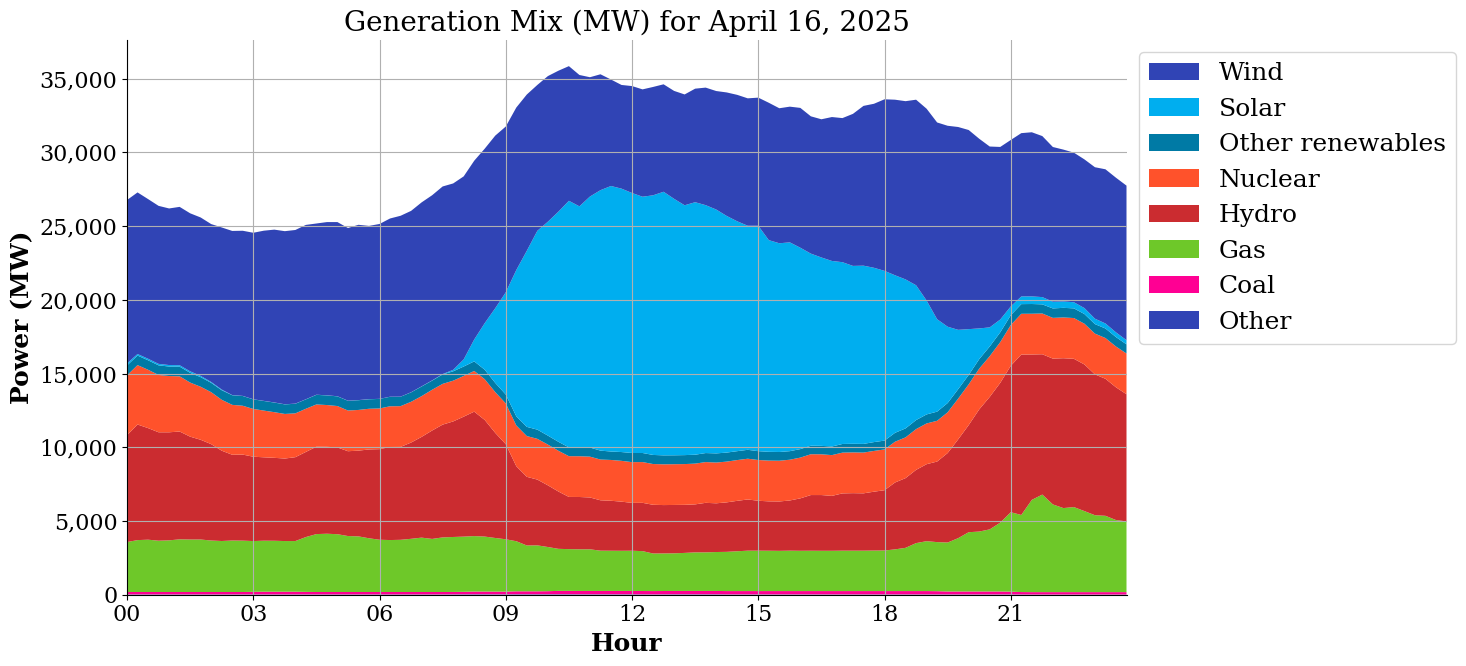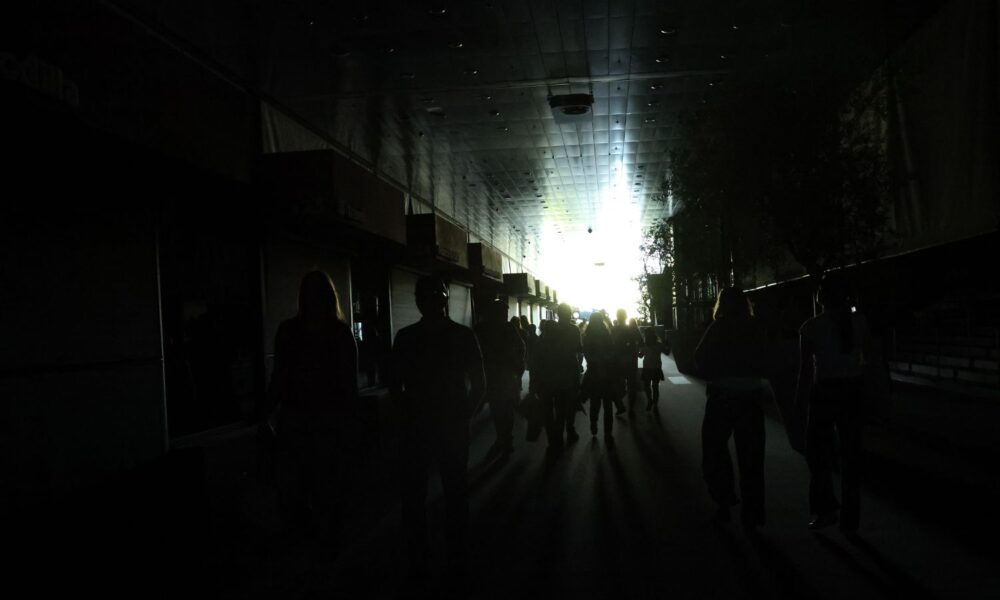Around 12:30pm local time on Monday, April 28, over two gigawatts (GW) of generation in Spain went offline. A few seconds later, Spain’s connection to the electric grid in France and the rest of Europe was severed, followed by a nearly complete power outage across Portugal and Spain, the two nations that make up the Iberian Peninsula.
Occurring during the middle of a workday, the blackout caused significant disruption. Over 35,000 passengers were stranded in trains stopped along the rails or underground and had to be rescued. Hospitals switched to backup generators in order to continue treating patients. The power outage led to the death of six people in Spain who died of carbon monoxide poisoning from a faulty backup generator, and one person in Portugal whose mechanical ventilator ran out of battery charge before emergency services arrived.
Following the outage, the Spanish and Portuguese grid operators immediately began efforts to restore service, aided by interconnections with France and Morocco. Power was fully restored by 11am on April 29, less than 24 hours after the outage began. The speed of the recovery is a striking contrast to estimates that a complete blackout in Texas following winter storm Uri could have taken months to recover from.
While details of the immediate cause of the blackout are becoming much clearer, there’s still a lot that isn’t known about the root causes, and what could or should have been done differently in response to the system disruptions that immediately preceded the outage.
But that uncertainty didn’t stop pro-fossil fuel voices from seizing the moment to baselessly blame renewables. Much of the speculation centered on the fact that the first generators which dropped offline were solar photovoltaics. But this overlooks a key point: solar accounted for nearly 60% of generation at the time in Spain. With so much solar on the system, it’s not surprising it was the first affected by any system-wide disturbance.
And as we’ll see, this early speculation not only wrongly blamed renewables, but it missed the fact that better use of renewables could have prevented the blackout in the first place.

Note that Spain’s electrical system is over four times larger than Portugal’s and manages the interconnections with both France and Morocco, so most of the analysis, including this blog, will focus on Spain.
What is grid inertia, and do we need it?
Initial speculation around the cause of the outage centered narrowly on one thing: inertia.
Inertia is the nature of moving objects to stay in motion, resisting changes in speed and direction. In conventional coal, gas, hydro, and nuclear plants, huge generators spin in sync with the grid. Across the grid, the large mass of these generators rotating synchronously provides a buffer, resisting rapid changes to the grid’s frequency.
Because renewables either do not use spinning generators, or don’t spin in sync with the grid, they are not able to provide this type of inertia. While wind turbines use spinning generators, in most cases they are not spinning in sync with the grid, instead being coupled through inverters, just like solar photovoltaics; thus the common name “inverter-based resources” or “IBRs,” a category which also includes batteries.
While it’s true that wind and solar don’t provide inertia, it’s also true that a grid dominated by wind and solar doesn’t need as much inertia. The benefit of inertia on the conventional grid is that when a big generator goes offline, inertia keeps the wheels spinning until others can take up the slack. For conventional generators, this can take a few seconds, so every second inertia buys you is important.
But wind and solar (and batteries too) can detect and respond to changes in grid frequency in fractions of a second. The challenge is that doing so requires careful design, planning, and implementation; while inertia in the conventional grid is a simple frequency control solution based on the physics of large synchronous generators, the so-called fast frequency response of renewables is a more complicated approach based on the intricacies of power electronics. As we’ll see, these intricacies, and how they’re regulated, played a big role in what happened on April 28.
Analysis indicates that inertia was largely irrelevant to the outage
Reuters, the Telegraph, and the New York Times all questioned whether the lack of inertia—which is provided by conventional generators, but not wind and solar—was to blame. Shortly following the event, however, some experts had already determined that lack of inertia was unlikely to be the root cause. It doesn’t take an expert to note that, clearly, the amount of renewables on the Spanish and Portuguese grids had not suddenly changed on April 28th, meaning that there must be some other root cause.
Data from ENTSO-E, the association of grid operators in Europe, easily confirms this is the case. Prior to April 28, there were 384 recorded 15-minute intervals in 2025 with a higher share of renewables than what was seen on April 28, and 57 days with a higher overall share of renewable generation.
In fact, the interval with the highest share of renewables occurred on April 16, just two weeks prior to April 28. Below you can see the generation mix on April 28 (with a line showing the start of the outage), and April 16 for comparison.


If the share of renewables or lack of inertia were to blame, then April 28th would not have been the first time a major outage occurred.
A pair of initial reports about the incident, released in June by the Government of Spain and Red Electrica (the grid operator), are even more conclusive. Michael Goggin of Grid Strategies provides the following concise summary:
Both reports also put to rest the preliminary but erroneous speculation from many parties, including some in the United States, that the event was caused by the high penetration of renewable generation causing inadequate inertia to maintain system frequency. The government report documents that inertia levels were more than adequate, as “the system operator indicates that before the incident the system had inertia levels of 2.3 seconds (excluding contributions through the interconnections), which is a value higher than the 2 seconds recommended by the European Network of Transmission System Operators for Electricity (ENTSOE)…” (107)
The grid operator even went so far as to say that “the system’s inertia in this incident is irrelevant because the system was already doomed by the massive loss of generation.”
The real culprit: under-reliance on renewables
Both reports go on to explain that renewables could have actually prevented the outage if they had been programmed differently.
While IBRs like wind and solar cannot provide mechanical inertia like traditional generators, there are multiple other ways that they can provide stability. One critical method is referred to variously as voltage control, voltage regulation, or reactive power compensation. And it turns out voltage, not inertia, was ultimately the main issue.
Voltage is the other parameter of the grid, in addition to frequency, that must be maintained within strict limits in order to ensure power is reliably delivered from generators to homes and businesses. However, where frequency is a universal value across all points of the grid which each generator can play a small role in managing, voltage varies widely across the grid and requires more granular control and significant coordination to manage.
Explained another way, if you take any two points on the grid, no matter how remote, the frequency will be essentially the same and every generator on the grid will have some small role in maintaining that frequency. But the voltage measured at any two points on the grid can vary greatly, even when those two points are at the same nominal voltage (i.e. not separated by transformers which intentionally change the voltage). Managing the voltage requires coordination between both centralized generators and localized measurement and control resources. Without the right tools in the right places, voltage will stray out of bounds causing damage, outages, or both.
One of the most effective tools for managing voltage is reactive power compensation (often simply called voltage control or voltage regulation due to how effective it is). Reactive power is a complicated topic, but the key insight is that while generators typically produce power with both the current and voltage in sync, many different types of loads and other factors pull them out of sync. This creates inefficiencies throughout the grid that reduce the voltage the farther you get from generation sources. Providing reactive power, especially nearer to loads, can bring the voltage and current back into sync, eliminating those inefficiencies and supporting stable voltage. In some cases generators also need to absorb reactive power to reduce voltages that have risen too high.
Most generators, including IBRs, are able to provide reactive power to accomplish voltage regulation. However, IBRs are particularly effective at doing so, because they are made of power electronics which can respond to changing conditions almost instantaneously. Inverters on solar arrays can even be programmed to provide reactive power at night.
For smaller renewables like rooftop solar, voltage regulation is already required by the relevant standards in both North America and Europe. From a technical perspective, there is no reason why such methods can’t also be applied to grid-scale renewables, though application of the requirements varies by jurisdiction.
Renewables were forced to the sideline
In Spain, a fateful decision was made in 2014 to require IBRs (wind, solar, and batteries) to operate at a fixed power factor, meaning they are not able to provide voltage regulation. In contrast, IBRs in North America have been required to provide voltage regulation since 2016.
Following the April outage, however, the requirement is likely to change for Spain. Both the government and the grid operator concluded that the lack of voltage regulation was the ultimate cause of the outage. With IBRs prevented, by law, from supplying voltage regulation in Spain, there’s a limited supply available from conventional generators, which must be dispatched ahead of time to provide this function. It’s not yet fully clear what precipitated the initial rise in voltage, but the reports conclude that a few hours before the outage, the voltage was rising out of compliance, and conventional generators were struggling to keep up, or even failing to respond entirely.
Eventually, this triggered a chain reaction where rising voltages caused generators to disconnect, a standard protection practice. This led to further increases in voltage (while also reducing the amount of reactive power regulation on the grid), causing more generators to disconnect, ultimately resulting in the total collapse of the grid.
As a result, a key recommendation of the reports from both the government and grid operator is that going forward, IBRs should be required to provide voltage regulation (and even be penalized for failing to do so). With more resources providing voltage regulation spread across the grid, the likelihood of such a chain reaction recurring is greatly diminished. The government report also notes that this change would bring other benefits in addition to reliability, such as reduced costs and lower emissions, since IBRs can provide voltage regulation more cost-effectively than conventional generators.
What comes next?
While the reports from the Spanish government and grid operator provide a lot of insight, there are still some unanswered questions about the factors which caused the grid’s voltage to be so far from its setpoint, and why the tools that normally manage voltage weren’t sufficient on April 28th. ENTSO-E, the grid operator, has convened a panel of experts and promised a report, expected in September, to provide a full explanation of the incident and detailed recommendations.
In the United States, the North American Electric Reliability Corporation (NERC), recently presented to the Federal Energy Regulatory Commission (FERC) on the incident. FERC is the government agency responsible for regulating electricity markets in the United States, while NERC represents the operators of the electricity markets and is responsible for developing and implementing the standards that govern how the grid is operated. NERC’s conclusion was that the North American grid is essentially safe from a similar type of outage, due in part to existing requirements for all generators, including IBRs, to provide voltage regulation. Some of these existing requirements are also in the process of being updated to provide even better protection.
While we wait for the definitive report on what caused the outage in Spain and Portugal, what we know so far offers a compelling narrative and a valuable lesson: instead of causing major blackouts, renewables are actually the tool we need to prevent them. When these 21st century tools are constrained by 20th century rules, outages are a major risk. But with careful engineering and a forward-looking perspective, we can build a grid that is clean, affordable, and reliable, where renewables are empowered to keep the lights on.

